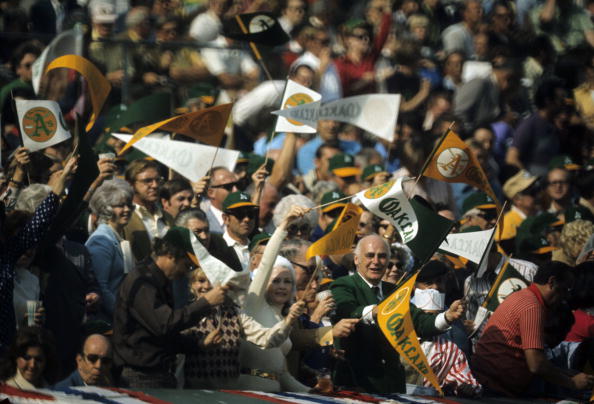Charlie Finley’s Oakland A’s played as one of two MLB teams to three-peat in the last six decades. But those Athletics remain characterized as much by their eccentricities as their victories.
Nancy Finley captures the quirky character of the green-and-gold in Finley Ball: How Two Outsiders Turned the Oakland A’s Into a Dynasty and Changed the Game Forever (Regnery, 2016).
The story of Finley’s A’s begins in Philadelphia in 1954, when Major League Baseball’s owners thwarted the insurance salesman’s attempt to purchase the team, which tellingly moved into the stadium of a New York Yankees minor league affiliate in Kansas City. New A’s owner Arnold Johnson owned Yankee Stadium. And the Yankees, as numerous suspicious trades strongly suggested, owned him. When Johnson died of a cerebral hemorrhage while watching his team play—the Kansas City A’s had that effect on a man—Nancy Finley’s cousin purchased the team and recruited her dad Carl to help run them.
The Finleys promptly and predictably irritated the baseball establishment. They ditched the drab but universal road uniforms of gray with gear of green and gold befitting a technicolor age but ill-suited for a traditionalist sport. Finley attempted to revive Bill Veeck’s Pitchometer to accelerate the pace of play. He launched a petting zoo, with the famous mule “Charlie O” as its centerpiece, to accentuate the playfulness of the ballpark. “One sheep died after a home run ball landed on its head, while another passed away from a heart attack while being chased around the zoo by an Athletics player,” Nancy Finley informs. “The pitcher Moe Drabowsky would use a fungo bat to hit the animals with a baseball before games, while young hurlers Catfish Hunter and Lew Krause found a way to drug the monkeys.”
But the A’s, who had previously eclipsed .500 in 1953 and last won the pennant in 1931, lost much in Kansas City, which resulted in Kansas City losing interest and the A’s moving to Oakland in 1968. There, the A’s meshed into the peculiar time and place. “When the Feds learned we lived next to [Black Panther leader] Huey Newton and associates, they approached Dad and Charlie, asking them to gather any information they could. Dad, who had once been a juvenile probation officer and had a cousin in the Dallas office of the FBI, was only too happy to oblige, and he started going through their garbage.” The emergence of the Symbionese Liberation Army prompted Carl Finley pulling the author from school after the group kidnapped heiress Patty Hearst.
As the Bay Area appeared to be losing its mind, the Oakland A’s began to win games. Fueled at the plate by Reggie Jackson, Joe Rudi, Sal Bando, and Gene Tenace, and on the mound by Catfish Hunter, Vida Blue, and Rollie Fingers, the A’s won their division from 1971 through 1975 and the World Series in 1972, 1973, and 1974.
The ultimate outsiders conquered baseball. And then innovations overran the ultimate innovators in Oakland. Free agency depleted the team’s mighty roster. The Bay Area’s high led to an awful hangover, of which the Oakland A’s enjoyed no immunity.
Karen Finley attributes the rise to an almost cosmic energy of her relative. “I can’t help thinking that one reason we lost the 1975 American League Championship Series is that Charlie Finley was not there,” she writes. “Looking at Charlie’s empty seat behind the dugout, it was obvious that the energy was missing.” But the energy came from youth in the form of an upstart Boston Red Sox squad that swept the A’s in the ALCS.
The market that gave rise to the A’s contributed to its downfall. Oakland, competing for fan allegiance in the Bay Area as a weak sister to the San Francisco Giants—themselves enduring rumors of a possible move—just couldn’t keep pace in the new era of free agency that Charlie Finley had endorsed.
Finley Ball reads as a celebration of a special team worth celebrating more than four decades later. As such, it includes criticism of Charlie Finley only to rebut it. The author writes that “jealous MLB owners concocted a revisionist history” to discredit the team’s owner and that “the unrelenting vilification of the sports media” doomed Charlie Finley from a public relations standpoint. The book tells a story of politicians railroading, journalists carping, and owners sniping.
Charlie Finley cultivated a me-against-the-world narrative. It eventually became a self-fulfilling prophecy, and like most battles between an individual and the mob, the mob eventually, and unsurprisingly, won. But for a few years the underdog owner, in a world-turned-upside-down era, ruled over the rulers.
Baseball, the ultimate game of tradition that plays, unlike football and basketball, almost exactly as it did a century ago, rebels against its rebels. But in time the game incorporates them as part of the rich tradition. So, though Charlie Finley, the man who put a woman in the announcer’s booth in the 1960s and put women in the seats in the 1970s by offering free admission to ladies wearing hot pants, remains on the outside of Cooperstown looking in, his amazing story weaves into the narrative of America’s amazing pastime. And as shown by how his $300 reward for players growing mustaches reignited a nineteenth-century tradition in twentieth-century baseball (see Rollie Fingers), those denounced for bucking old ways often establish them anew.
It wasn’t Moneyball. It was better. Finley Ball, the era and the book, is fun.

COMMENTS
Please let us know if you're having issues with commenting.